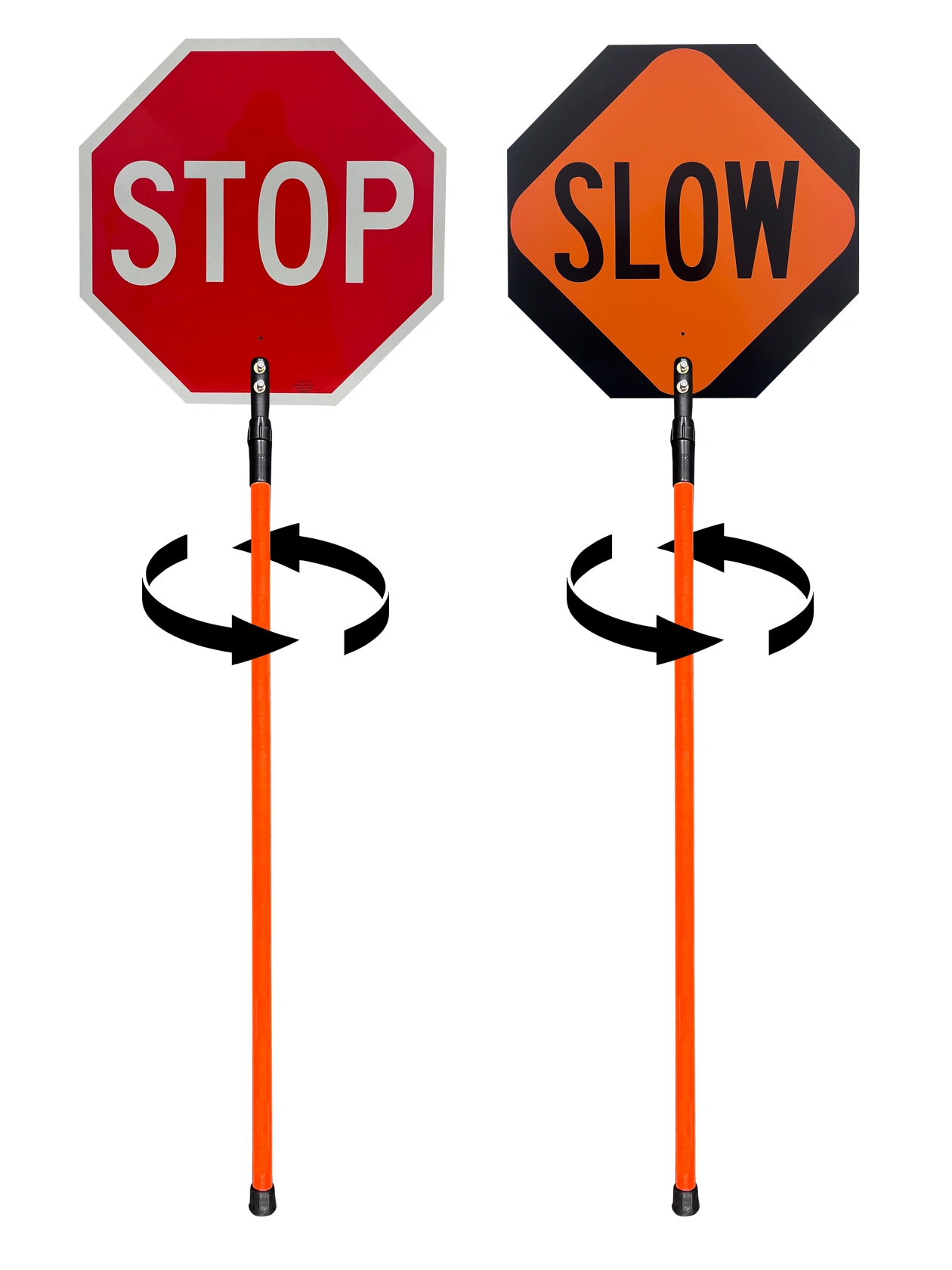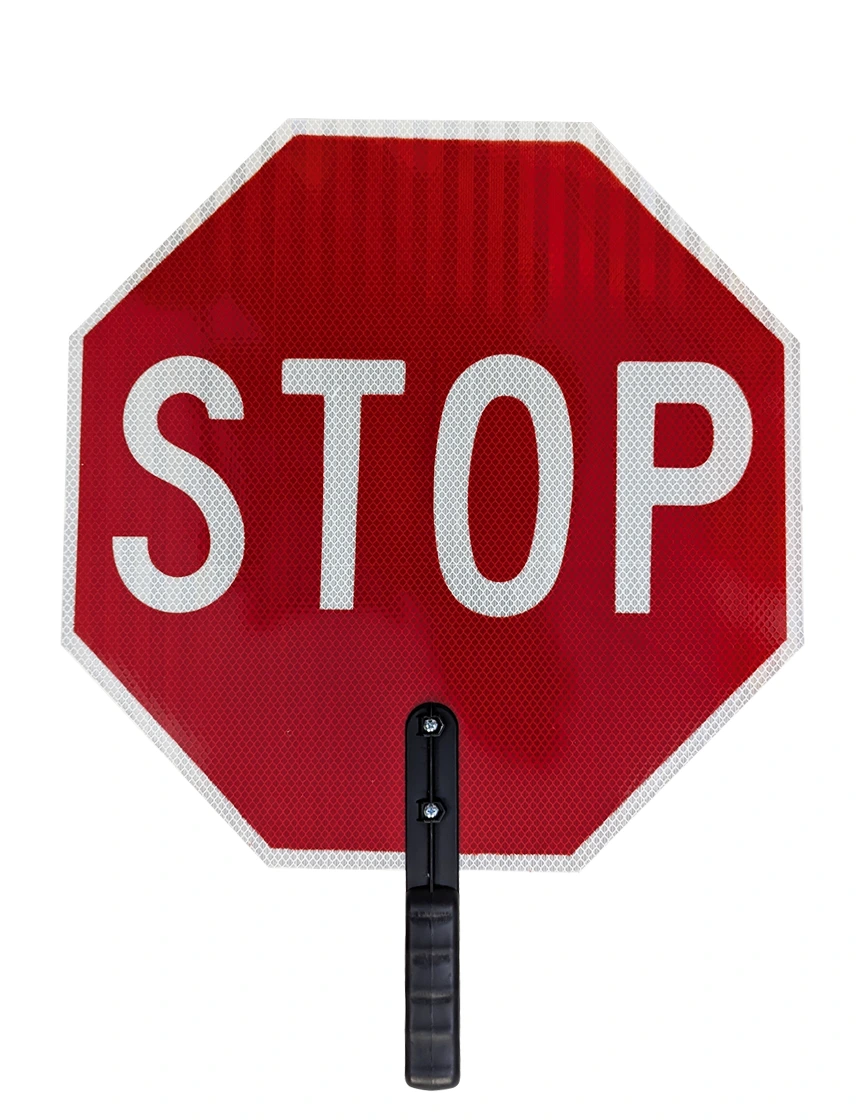What Is a STOP/SLOW Paddle? The Flagger’s #1 Tool for Work Zone Safety
A STOP/SLOW paddle is a two-sided, handheld sign that enables a trained flagger to deliver clear, unambiguous instructions to drivers approaching construction work zones. One side displays the regulatory STOP message, while the other shows an advisory SLOW message. By rotating the paddle, a flagger can seamlessly switch between stopping traffic and allowing it to proceed, ensuring safe and orderly flow through single-lane closures, lane shifts, and other temporary traffic control (TTC) setups.1Design & MUTCD Requirements
The Manual on Uniform Traffic Control Devices (MUTCD), published by the Federal Highway Administration (FHWA), sets the standards for STOP/SLOW paddles in the United States. Below are the key requirements from MUTCD §6E.03 (11th Edition, 2023), assumed current as of June 2025 unless superseded:- Shape & Size: The paddle must be octagonal, at least 18 inches (450 mm) wide, with letters a minimum of 6 inches (150 mm) tall for legibility.1
- Colors: A red background with white lettering for STOP; an orange background with black lettering for SLOW.1
- Night Visibility: The paddle must be retroreflective, typically using high-intensity sheeting, to ensure visibility after dark. Flashing white LEDs around the border are permitted to enhance conspicuity.2
- Optional Oversize: A 24-inch (600 mm) paddle is recommended for roads where speeds exceed 60 mph to improve visibility at higher closing distances.3
- Handle: A lightweight, rigid staff, typically long enough to position the sign at chest height (about 3–5 feet, depending on the flagger), keeps it visible without obstructing the flagger’s movements.1
How Flaggers Use the Paddle to Control Traffic
Flaggers must be trained and certified according to state or federal guidelines (e.g., through programs like those offered by the American Traffic Safety Services Association) to use the paddle effectively. Here’s how they deploy it in three common scenarios:1. Stopping Traffic
The flagger faces oncoming vehicles, presents the STOP side squarely, and extends their free arm palm-out at shoulder height. This reinforces the command with a universal hand signal, ensuring drivers stop at a precise point.42. Releasing or “Proceed”
When the work zone is clear, the flagger rotates the paddle to SLOW, holds it steady, and uses a smooth, sweeping motion with their free hand to signal drivers to proceed. In two-flagger setups, coordination via two-way radio (e.g., “Eastbound clear, release westbound”) ensures safe alternation of traffic directions.53. Speed Reduction / Caution
For situations requiring reduced speed—such as equipment crossing—the flagger displays the SLOW side and makes a gentle up-and-down hand motion. This clear signal prompts drivers to slow down without stopping.6Flagger Station Setup & Communication
Effective flagging requires careful positioning and support:- Sight Distance: The MUTCD mandates placing the flagger far enough upstream so drivers traveling at the posted speed can see the paddle and stop smoothly—often 200–500 feet, depending on speed and terrain.7
- Advance Warning: Signs like “FLAGGER AHEAD” (W20-7a), often with flashing beacons on high-speed roads, alert drivers early.7
- Two-Flagger Operations: In one-lane, two-way setups, flaggers at each end use radios for precise coordination, avoiding conflicts.5
- High-Visibility Apparel: Flaggers wear ANSI 107 Class 2 or 3 garments (e.g., neon yellow-green vests) to remain conspicuous day or night.8
Why a Paddle Beats a Hand Flag
Compared to traditional hand flags, STOP/SLOW paddles offer distinct advantages:- Clarity: The octagonal STOP shape and standardized colors (red and orange) are instantly recognizable, even at speeds above 50 mph.
- Less Ambiguity: A rigid paddle avoids the misinterpretation caused by windblown or faded flags.
- Worker Safety: Requiring only one hand, the paddle frees the flagger’s other hand for balance or additional signaling, reducing fatigue and risk.
Common Challenges and How to Avoid Them
Even with a well-designed tool, flagging can face pitfalls:- Improper Positioning: Flaggers must stand where drivers can see them—outside traffic lanes and not in blind spots. Training emphasizes optimal placement.
- Inconsistent Signaling: Clear, deliberate movements prevent confusion; flaggers avoid rushed or vague gestures.
- Driver Non-Compliance: Some drivers ignore signals. Flaggers are trained to step aside if needed and report incidents to supervisors.
Advanced Options
Technology enhances paddle functionality:- LED-Rimmed Paddles: Border lights improve visibility in fog, rain, or darkness.
- Automated Flagger Assistance Devices (AFADs): These remote-controlled units place the paddle on a mechanized arm, reducing flagger exposure to traffic and improving signaling consistency.9 AFADs are especially valuable on high-volume roads.
Work Zone Safety Impact
Proper flagging saves lives. The National Institute for Occupational Safety and Health (NIOSH) reports that work zone crashes claimed over 800 lives in 2020 alone, with many preventable through effective traffic control. STOP/SLOW paddles, wielded by trained flaggers, are a proven tool for reducing these risks.Purchasing & Compliance
For MUTCD-compliant options, retailers like TrafficSafetyStore.com offer 18-inch and 24-inch paddles, LED variants, and durable handles with fast shipping. Always verify compliance with the latest MUTCD edition.Takeaway
The STOP/SLOW paddle is more than a simple sign—it’s a federally mandated lifeline engineered for clarity in chaotic work zones. When used correctly by trained flaggers, it protects workers, guides drivers, and prevents accidents, making it an indispensable tool for safety and efficiency. Its proper deployment can mean the difference between a routine workday and a tragedy.Citations
- MUTCD Chapter 6E, “Flagger Control,” FHWA, 11th Ed., 2023. https://mutcd.fhwa.dot.gov/pdfs/11th_Edition/part6.pdf
- MoDOT Engineering Policy Guide §616.5. https://epg.modot.org/index.php/616.5_Flagger_Control
- FHWA Freight Management & Ops, “Traffic Control.” https://ops.fhwa.dot.gov/publications/fhwahop16051/ch4.htm
- MUTCD Chapter 6E, Hand-Signal Guidance, 11th Ed. https://mutcd.fhwa.dot.gov/pdfs/11th_Edition/part6.pdf
- Ibid.
- Ibid.
- MUTCD §6E.03, Sight Distance Standards, 11th Ed. https://mutcd.fhwa.dot.gov/pdfs/11th_Edition/part6.pdf
- ATSSA Work Zone Safety Module. https://www.atssa.com/wp-content/uploads/2023/12/Module_OverviewMUTCDPt6TTC.pdf
- FHWA Tech Brief on AFADs. https://ops.fhwa.dot.gov/publications/fhwahop17042/fhwahop17042.pdf
Learn more about Safety Vests, Road Flares, and Traffic Cones at TrafficSafetyStore.com – for all your traffic safety needs.
Stay Safe. Stay Compliant. Choose Traffic Safety Store.

24" STOP/SLOW Paddles
Quick Facts:
- 24" Aluminum Sign Face
- Available in Non-Reflective, EG or HI Reflective
- Orange fiberglass 'Telescoping' Handle extends from 52" all the way up to 96"


18" Heavy-Duty STOP/STOP Paddles
18" Heavy-Duty STOP/SLOW Paddles
Quick Facts:
- 3 finishes to choose from; Non-Reflective, EG or HI Reflective
- 4.5 mil Polycarbonate Sign Face
- STOP on one side, SLOW on the other
- 9" handle (Extends 4 1/2" below the bottom of the sign face)


